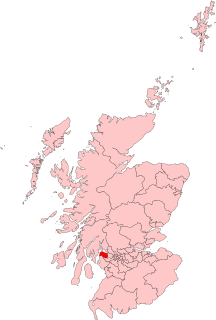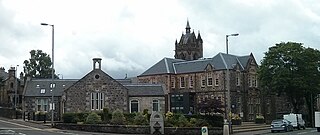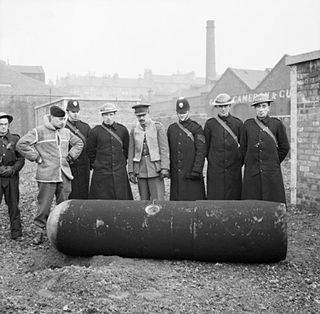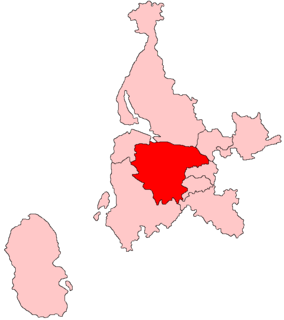Related Research Articles

Inverclyde is one of 32 council areas used for local government in Scotland. Together with the East Renfrewshire and Renfrewshire council areas, Inverclyde forms part of the historic county of Renfrewshire, which currently exists as a registration county and lieutenancy area – located in the west central Lowlands. It borders the North Ayrshire and Renfrewshire council areas, and is otherwise surrounded by the Firth of Clyde.

Greenock is a town and administrative centre in the Inverclyde council area in Scotland and a former burgh within the historic county of Renfrewshire, located in the west central Lowlands of Scotland. It forms part of a contiguous urban area with Gourock to the west and Port Glasgow to the east.

Port Glasgow is the second-largest town in the Inverclyde council area of Scotland. The population according to the 1991 census for Port Glasgow was 19,426 persons and in the 2001 census was 16,617 persons. The most recent census in 2011 states that the population has declined to 15,414. It is located immediately to the east of Greenock and was previously a burgh in the county of Renfrewshire.
Port Glasgow Junior Football Club is a Scottish football club, based in the town of Port Glasgow, Inverclyde.

Inverclyde is a parliamentary constituency of the House of Commons of the Parliament of the United Kingdom. It replaced Greenock and Inverclyde and the Port Glasgow and Kilmacolm areas from West Renfrewshire for the 2005 general election.

Kilmacolm is a village and civil parish in the Inverclyde council area, and the historic county of Renfrewshire in the west central Lowlands of Scotland. It lies on the northern slope of the Gryffe Valley, 7+1⁄2 miles southeast of Greenock and around 15 miles (24 km) west of the city of Glasgow. The village has a population of around 4,000 and is part of a wider civil parish which covers a large rural hinterland of 15,000 hectares containing within it the smaller settlement of Quarrier's Village, originally established as a 19th-century residential orphans' home.
Larkfield is the largest council housing estate in Greenock, Inverclyde, Scotland.

The Greenock Blitz is the name given to two nights of intensive bombing of the town of Greenock, Scotland by the Nazi German Luftwaffe during the Second World War. The raids over the nights of the 6 and 7 May 1941 targeted the shipyards and berthed ships around the town. The brunt of the bombing fell on residential areas. Over the two nights, 271 people were killed and over 10,200 injured. From a total of 180,000 homes nearly 25,000 suffered damage and 5,000 were destroyed.

Greenock West railway station is a station in Greenock, Scotland, located on the Inverclyde Line which runs from Gourock to Glasgow Central. The route is currently operated by ScotRail under the auspices of Strathclyde Partnership for Transport. Each service to and from Glasgow on the Inverclyde Line stops at this station.

Renfrewshire or the County of Renfrew is a historic county, registration county and lieutenancy area in the west central Lowlands of Scotland. It contains the local government council areas of Inverclyde, Renfrewshire and East Renfrewshire, as well as parts of Glasgow and is occasionally named Greater Renfrewshire to distinguish the county from the modern council area.

The James Watt College was a further education college in Greenock, Scotland. It is now part of West College Scotland. There were also campuses in Largs and Kilwinning which now form part of Ayrshire College as the result of the merger with Kilmarnock College and Ayr College.

West Renfrewshire was a constituency of the Scottish Parliament (Holyrood). It elected one Member of the Scottish Parliament (MSP) by the first past the post method of election. Also, however, it was one of nine constituencies in the West of Scotland electoral region, which elected seven additional members, in addition to nine constituency MSPs, to produce a form of proportional representation for the region as a whole.
Wellington Academy was a secondary school at Dempster Street in Greenock, Scotland serving the Eastern and Central areas of the town. In 2007 it merged with Greenock High School to form Inverclyde Academy.

The megalithic Kempock Stone, popularly known as Granny Kempock, stands on a cliff behind Kempock Street, the main shopping street in Gourock, Scotland. The stone, or menhir, is grey mica schist and of indeterminate origin, but it has been suggested that it is an old altar to the pagan god Baal, or a memorial to an ancient battle. Supposedly there is a superstition that for sailors going on a long voyage or a couple about to be married, walking seven times around the stone would ensure good fortune. A flight of steps winds up to the stone from Kempock Street below.

The McLean Museum and Art Gallery is a museum and art gallery situated in Greenock, Inverclyde, Scotland. It is the main museum in the Inverclyde area, it is free to visit and was opened in 1876. Most notably it features an exhibition of items related to James Watt, the Greenock-born inventor, a Mummy Cartonnage from Herakleopolis Magna and a collection of British and Scottish art. The principal entrance to the museum is on Kelly Street, in the Greenock West area. The former Curator is Val Boa. The Watt Institution includes the Art Gallery, Watt Hall, Watt Library and Inverclyde Archives.
Fort Matilda is a suburb at the far western edge of Greenock, Scotland. Its name comes from a coastal battery built on Whiteforeland Point 1814–1819 to defend the River Clyde.
The lands of Finnart to the west of Greenock belonged to the Earl of Douglas in medieval times. Around 1455 they were forfeited to the crown. Finnart was given to the Hamiltons, while the western part of the barony of Finnart went to Stewart of Castlemilk and became the barony of Finnart-Stewart, or Gourock.

Spango Valley is a steep sided valley to the south-west of Greenock, Scotland. It runs approximately south west to north east for around 1.5 miles (2.4 km) from the confluence of the Spango Burn and Kip Water near Dunrod Farm, to Ravenscraig at the present day Aileymill Gardens. A small stream known as the Spango Burn, runs along the valley floor. The originally meandering burn has been channelised and straightened for much of its length as it runs south west through the valley.

The Old West Kirk of the Church of Scotland, authorised by a 1589 Royal Charter and first opened in 1591, is noted as the first Presbyterian church built in Scotland following the Scottish Reformation, and the first approved by the Parliament of Scotland. At an early stage, east and west aisles were added as transepts, giving the church its cruciform plan.

The Watt Library or Watt Monument Library in Greenock, Scotland, opened on its current site in 1837 and was the direct descendant of the Greenock Library, a subscription library founded in 1783. It closed as a subscription library in 1971 and re-opened as a public facility in 1973 under the name of the Watt Library, specialising in Local History and Archives. The building was designed in the Gothic revival style by architect Sir Edward Blore and is a listed building. It has undergone recent refurbishment and re-opened in November 2019 as the Watt Institution, incorporating the McLean Museum Watt Lecture Hall and Inverclyde Archives.
References
- ↑ "Gallery: Greenock Coin Hoard". Inverclyde Council. Retrieved 7 August 2009.[ permanent dead link ]